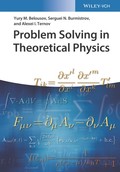Problem Solving in Theoretical Physics

1. Auflage September 2020
528 Seiten, Softcover
46 Abbildungen
Lehrbuch
Kurzbeschreibung
"Problem Solving in Theoretical Physics" helps students mastering their theoretical physics courses by posing advanced problems and providing their solutions - along with discussions of their physical significance and possibilities for generalization and transfer to other fields.
Jetzt kaufen
Preis: 105,00 €
Preis inkl. MwSt, zzgl. Versand
Euro-Preise für Wiley-VCH- und Ernst & Sohn-Titel sind nur für Deutschland gültig. In EU-Ländern gilt die lokale Mehrwertsteuer. Portokosten werden berechnet.
CHAPTER 1. THEORY OF FIELDS
Introduction
1.1 Vectors and tensors in the Euclidean space
1.2 Vectors and tensors in the Minkowski space
1.3 Relativistic kinematics
1.4 The Maxwell equations
1.5 Motion of a charged particle in the external field
1.6 Static electromagnetic field
1.7 Free electromagnetic field
1.8 The retarded potentials and radiation
1.9 Electromagnetic field of relativistic particles
1.10 The scattering of electromagnetic waves
CHAPTER 2. QUANTUM MECHANICS
Introduction
2.1 Operators and states in the quantum mechanics
2.2 One-dimensional motion
2.3 Linear harmonic oscillator
2.4 Angular momentum and spin
2.5 Motion in the magnetic field
2.6 Motion in the centrally symmetric field
2.7Semiclassical approximation
2.8 Perturbation theory
2.9 Relativistic quantum mechanics
2.10 Addition of angular momenta. The identity of particles
2.11 Theory of atoms and molecules
2.12 Theory of scattering
2.13 Theory of radiation
CHAPTER 3. STATISTICAL PHYSICS
Introduction
3.1 The Gibbs distribution. The thermodynamic quantities and functions
3.2 Quantum ideal gases
3.3 Non-ideal quantum systems (liquids)
3.4 Phase transitions and the critical phenomena
SOLUTIONS TO THE PROBLEMS
CHAPTER 4. THEORY OF FIELDS
4.1 Vectors and tensors in the Euclidean space
4.2 Vectors and tensors in the Minkowski space
4.3 Relativistic kinematics
4.4 The Maxwell equations
4.5 Motion of a charged particle in the external field
4.6 Static electromagnetic field
4.7 Free electromagnetic field
4.8 The retarded potentials and radiation
4.9 Electromagnetic field of relativistic particles
4.10 The scattering of electromagnetic waves
CHAPTER 5. QUANTUM MECHANICS
5.1 Operators and states in the quantum mechanics
5.2 One-dimensional motion
5.3 Linear harmonic oscillator
5.4 Angular momentum and spin
5.5 Motion in the magnetic field
5.6 Motion in the centrally symmetric field
5.7 Semiclassical approximation
5.8 Perturbation theory
5.9 Relativistic quantum mechanics
5.10 Addition of angular momenta. The identity of particles
5.11 Theory of atoms and molecules
5.12 Theory of scattering
5.13 Theory of radiation
CHAPTER 6. STATISTICAL PHYSICS
6.1 The Gibbs distribution. The thermodynamic quantities and functions
6.2 Quantum ideal gases
6.2.1 Ideal Fermi gas
6.2.2 Ideal Bose gas
6.2.3 Ideal gas of elementary Bose excitations
6.3 Non-ideal quantum systems (liquids)
6.3.1 Normal (nonsuperfluid) Fermi liquid
6.3.2 Superconductivity. The BCS theory
6.3.3 Weakly interacting Bose gas
6.3.4 Theory of superfluidity
6.4 Phase transitions and the critical phenomena
6.4.1 The mean-field approximation
6.4.2 The Ginzburg-Landau functional
6.4.3 The fundamentals of the theory of critical phenomena
APPENDICES
1 Dirac delta function and other distributions
2 Bessel functions of half-integer order
3 Confluent hypergeometric function. The Laguerre polynomials
4 Gamma function
Serguei N. Burmistrov is Researcher and Lecturer at the Russian Research Center "Kurchatov Institute", Moscow, Russia.
Alexei I. Ternov is Researcher and Lecturer at the Moscow Institute of Physics and Technology, Dolgoprudny, Russia.


